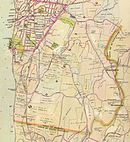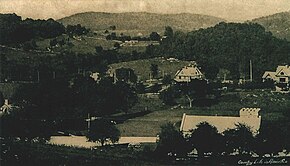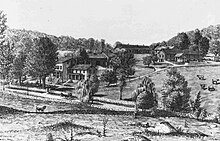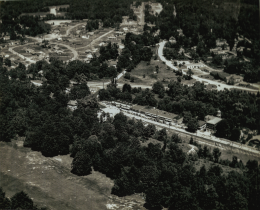
Briarcliff Manor is a suburban village in Westchester County, New York, 30 miles (50 km) north of New York City. It is on 5.9 square miles (15 km2) of land on the east bank of the Hudson River, geographically shared by the towns of Mount Pleasant and Ossining. Briarcliff Manor includes the communities of Scarborough and Chilmark, and is served by the Scarborough station of the Metro-North Railroad's Hudson Line. A section of the village, including buildings and homes covering 376 acres (152 ha), is part of the Scarborough Historic District and was listed on the National Register of Historic Places in 1984. The village motto is "A village between two rivers", reflecting Briarcliff Manor's location between the Hudson and Pocantico Rivers. Although the Pocantico is the primary boundary between Mount Pleasant and Ossining, since its incorporation the village has spread into Mount Pleasant.
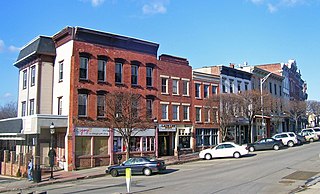
Ossining is a village in Westchester County, New York, United States. The population at the 2020 United States census was 27,551, an increase from 25,060 at the 2010 census. As a village, it is located in the town of Ossining.

Ossining is a town located along the Hudson River in Westchester County, New York. The population was 40,061 at the time of the 2020 census. It contains two villages, the Village of Ossining and part of Briarcliff Manor, the rest of which is located in the Town of Mount Pleasant. Ossining is the location of Sing Sing maximum-security prison.

The Scarborough station is a commuter rail stop on the Metro-North Railroad's Hudson Line, located in the Scarborough area of Briarcliff Manor, New York. Trains leave for New York City every hour on weekdays, and about every 25 minutes during rush hour. It is 28.7 miles (46.2 km) from Grand Central Terminal, and the trip there takes about 50 minutes. Trains of electric multiple units serve the station. The Scarborough station is within walking distance of most houses in the neighborhood.
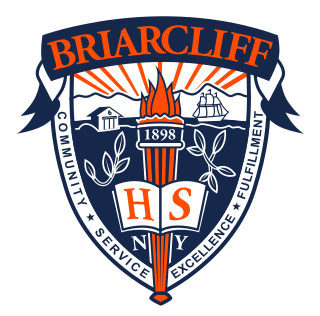
Briarcliff High School (BHS) is a public secondary school in Briarcliff Manor, New York that serves students in grades 9–12. It is the only high school in the Briarcliff Manor Union Free School District, sharing its campus with Briarcliff Middle School. As of 2021, the principal is Diana Blank and the assistant principal is Daniel Goldberg.

Briarcliff College was a women's college in Briarcliff Manor, New York. The school was founded as Mrs. Dow's School for Girls in 1903 at the Briarcliff Lodge. After Walter W. Law donated land and a building for the college, it operated at its location at 235 Elm Road in Briarcliff until 1977; closing due to low enrollment and financial problems. Pace University subsequently operated it as part of its Pleasantville campus from 1977 to 2015. In an effort to consolidate its campuses, Pace University sold the campus in 2017 to the Research Center on Natural Conservation, a host of conferences relating to global warming and conservation. The campus was again sold in 2021, to a Viznitz Yeshiva congregation.

Carmino Ravosa was an American composer and lyricist, singer, pianist, as well as a producer, director, and musical historian. Ravosa, who wrote music for children for decades, was one of the most popular songwriters for schools in America. He was an author and editor for Silver Burdett & Ginn's music textbook series "World of Music" and "The Music Connection", and the composer of the theme musicals in the two series. Ravosa also was the songwriter for the CBS children's shows Captain Kangaroo and Romper Room, the PBS program Shining Time Station, and the PBS publication Sesame Street Magazine.
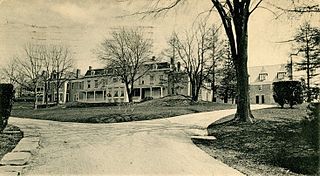
Dr. Holbrook's Military School was a military academy and boarding school for boys. The school was located in the town of Ossining and overlooked the Hudson River. After the 1906 annexation of Scarborough by the village of Briarcliff Manor, Holbrook's became part of the village within Ossining.
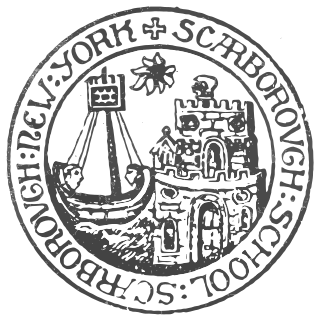
The Scarborough Day School was a private school in Scarborough-on-Hudson, in Briarcliff Manor, New York. Frank and Narcissa Cox Vanderlip established the school in 1913 at their estate, Beechwood. The school, a nonsectarian nonprofit college preparatory day school, taught students at pre-kindergarten to twelfth grade levels and had small class sizes, with total enrollment rarely exceeding 150 students. Since 1980, the buildings and property have been owned by The Clear View School, which runs a day treatment program for 83 students. The current school still uses the Scarborough School's theater, which was opened in 1917. The school campus is a contributing property to the Scarborough Historic District.
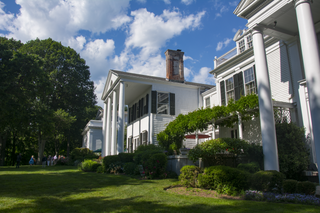
Beechwood is a Hudson River estate in Scarborough-on-Hudson, in Briarcliff Manor, New York. The estate was most notably the home of Frank A. Vanderlip and his family, and is a contributing property to the Scarborough Historic District. The house and property were owned by the Vanderlip family from 1906 to 1979. The property is now a 37-condominium complex as the result of a development project that began in the 1980s.

The Scarborough Historic District is a national historic district located in the suburban community of Scarborough-on-Hudson, in Briarcliff Manor, New York. The 376-acre (152 ha) district was added to the National Register of Historic Places in 1984, and contains seven historically and architecturally significant properties dating from the late 18th century to the early 20th century. Most of the properties are domestic, or used for education or religion. The most common architectural styles within the district are Mid-19th Century Revival and Late Victorian.
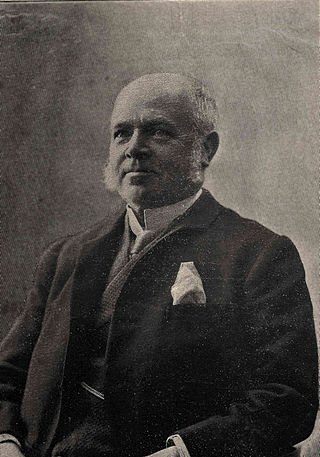
Walter William Law was a businessman and the founder of the 8,000-person village of Briarcliff Manor, New York. He was a vice president of furniture and carpet retailer W. & J. Sloane, and later founded the Briarcliff Lodge, the Briarcliff Table Water Company, Briarcliff Farms, and the Briarcliff Greenhouses. He founded or assisted in establishing several schools, churches, and parks in the village, and rebuilt its train station in 1906. In the early 1900s, Walter Law was the largest individual landholder in Westchester County.
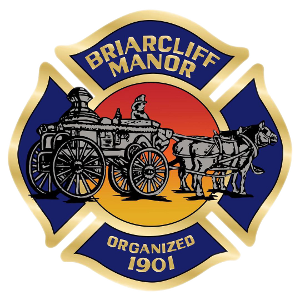
The Briarcliff Manor Fire Department (BMFD) provides fire protection and emergency medical services to the village of Briarcliff Manor, New York and its hamlet Scarborough. The volunteer fire department also serves unincorporated areas of Ossining and Mount Pleasant. The fire department has three fire companies, two stations, and four fire engines. Its engines include three pumpers and a tower-ladder; the department also maintains other vehicles, including a heavy rescue vehicle. The Briarcliff Manor Fire Department Ambulance Corps provides emergency medical transport with two ambulances. The fire department is headquartered at the Briarcliff Manor Village Hall, with its other station in Scarborough, on Scarborough Road.

The Briarcliff Lodge was a luxury resort in the village of Briarcliff Manor, New York. It was a notable example of Tudor Revival architecture, and was one of the largest wooden structures in the United States. It was also the first hotel in Westchester County. Walter William Law had it built on his estate, and the Law family owned it until 1937. When the lodge opened in 1902, it was one of the largest resort hotels in the world. The lodge hosted presidents, royalty, and celebrities, and was the scene of numerous memorable occasions for visitors and local residents who attended weddings, receptions, and dances in the ballroom and dining room. For a long time, the lodge was situated among other businesses of Walter Law, including the Briarcliff Farms and Briarcliff Table Water Company.

The Pocantico River is a nine-mile-long (14 km) tributary of the Hudson River in western central Westchester County, New York, United States. It rises from Echo Lake, in the town of New Castle south of the hamlet of Millwood, and flows generally southwest past Briarcliff Manor to its outlet at Sleepy Hollow. Portions of the towns of Mount Pleasant and Ossining are within its 16-square-mile (41 km2) watershed.
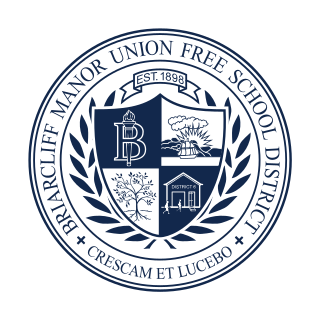
The Briarcliff Manor Union Free School District is the public school district of Briarcliff Manor, New York. The district is an independent public entity, and is governed by the district Board of Education, whose members are elected in non-partisan elections for staggered, three-year terms. The board selects a superintendent, who is the district's chief administrative official. The district's offices are located in Todd Elementary School.

Archville is a hamlet in Mount Pleasant in Westchester County, New York, United States. The hamlet consists of residences, businesses, and a fire station on Union Street, Arch Hill, and Requa Street, all abutting U.S. Route 9. Directly across Route 9 lies Rockwood Hall, part of the Rockefeller State Park Preserve. The volunteer Archville Fire Department serves the hamlet and surrounding area, from the Hudson River to Pocantico Lake and from the edge of Briarcliff Manor to the edge of Sleepy Hollow.
The history of Briarcliff Manor, a village in Westchester County, New York, can be traced back to the founding of a settlement between the Hudson and Pocantico Rivers in the 19th century. The area now known as Briarcliff Manor had seen human occupation since at least the Archaic period, but significant growth in the settlements that are now incorporated into the village did not occur until the Industrial Revolution. The village, which was incorporated with one square mile in 1902, has expanded primarily through annexation: of Scarborough in 1906 and from the town of Mount Pleasant in 1927 to its current area of 6.7 square miles (17 km2). The village has also grown in population; from 331 when established to 7,867 in the 2010 census.

The Briarcliff Manor Public Library is the public library serving the village of Briarcliff Manor, New York, and is located on the edge of the Walter W. Law Memorial Park. The library is a founding member of the Westchester Library System. It is staffed by a director and eleven employees, including reference and youth librarians, and is governed by a ten-member board, with a liaison to the village board of trustees. The library offers computer classes, book discussion groups, young adult programs, a children's room and a local history collection. The library building also houses the Briarcliff Manor-Scarborough Historical Society, the Briarcliff Manor Recreation Department, and the William J. Vescio Community Center.

Briarcliff Farms was a farm established in 1890 by Walter William Law in Briarcliff Manor, a village in Westchester County, New York. One of several enterprises established by Law at the turn of the 20th century, the farm was known for its milk, butter, and cream and also produced other dairy products, American Beauty roses, bottled water, and print media. At its height, the farm was one of the largest dairy operations in the Northeastern United States, operating about 8,000 acres (10 sq mi) with over 1,000 Jersey cattle. In 1907, the farm moved to Pine Plains in New York's Dutchess County, and it was purchased by New York banker Oakleigh Thorne in 1918, who developed it into an Aberdeen Angus cattle farm. After Thorne's death in 1948, the farm changed hands several times; in 1968 it became Stockbriar Farm, a beef feeding operation. Stockbriar sold the farmland to its current owners in 1979.
